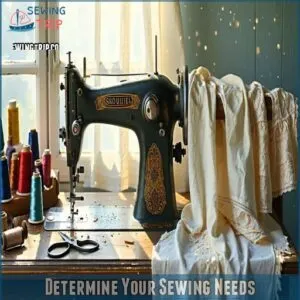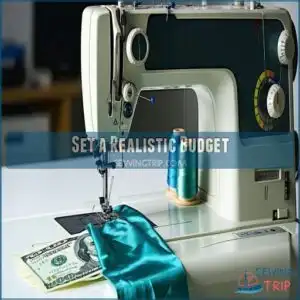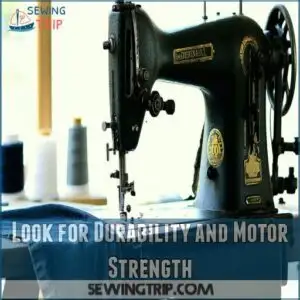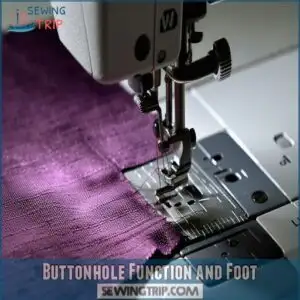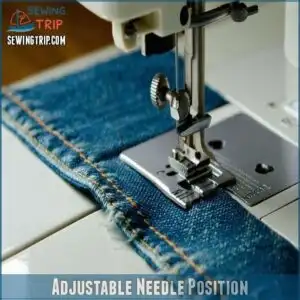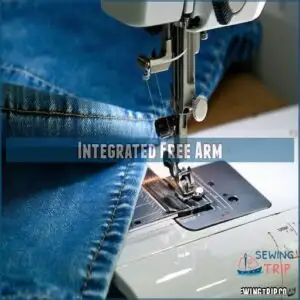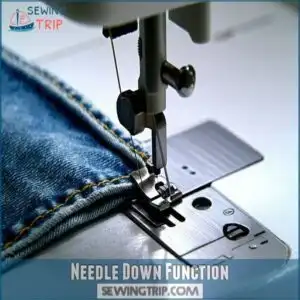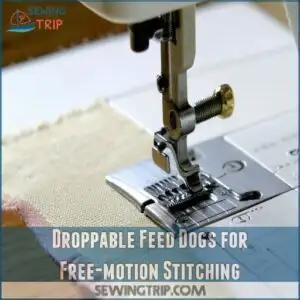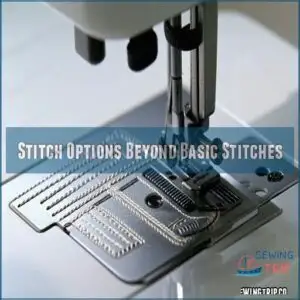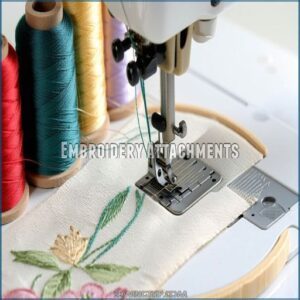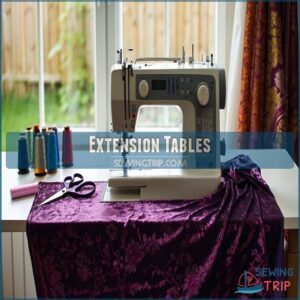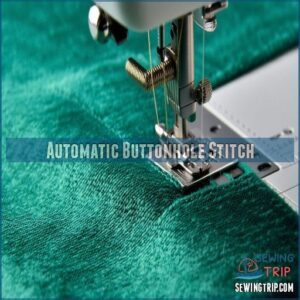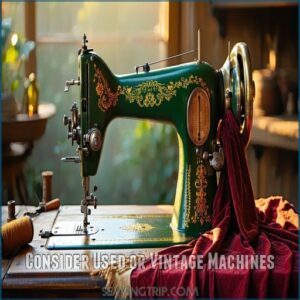This site is supported by our readers. We may earn a commission, at no cost to you, if you purchase through links.
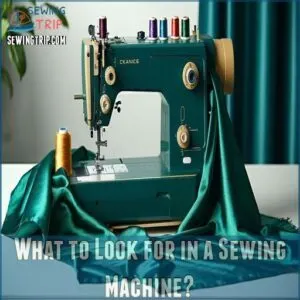 Choosing what to look for in a sewing machine doesn’t have to feel like finding a needle in a haystack. You’ll want to match the machine to your needs, whether you’re stitching simple repairs or dreaming of quilting masterpieces.
Choosing what to look for in a sewing machine doesn’t have to feel like finding a needle in a haystack. You’ll want to match the machine to your needs, whether you’re stitching simple repairs or dreaming of quilting masterpieces.
Start with the basics: adjustable stitch length and width, buttonhole function, and needle position control. Expect to invest at least $175 for a quality new machine with metal internal parts and a sturdy motor.
Remember to factor in the free arm feature for sleeves and pant legs – it’s a real game-changer. With the right features at your fingertips, you’ll be ready to tackle any project that catches your creative eye.
Table Of Contents
Key Takeaways
- You’ll need to spend at least $175 for a quality new machine with metal internal parts and a sturdy motor that can handle different fabric types.
- Your must-have features should include adjustable stitch length and width, buttonhole function, needle position control, and a free arm for working with sleeves and pant legs.
- Consider your skill level and future projects when choosing a machine – don’t limit yourself to basic features if you plan to tackle more complex projects like quilting or working with thick fabrics.
- Make sure you have access to reliable service, warranty coverage, and accessories through a reputable dealer who can support your machine’s maintenance needs.
What to Look for in a Sewing Machine?
A sewing machine can feel like an extension of your creativity, so let’s find the perfect fit. First, think about what you’ll be stitching—delicate silks or tough denim? This helps you nail down fabric compatibility and needed machine durability.
Your sewing machine comparison should consider sewing machine types, too. Are you a beginner or ready to upgrade? Factor in your skill level and where you see your sewing journey going. Understanding sewing machine basics is fundamental for making an informed decision.
Don’t break the bank, but remember, a quality machine is an investment. Expect to spend at least $175 for a new one, or explore used machines for savings. Check that motor strength can handle your fabric choices. Essential sewing machine features include adjustable stitch length and a buttonhole function. Think about thread quality and sewing speed, too.
Don’t forget maintenance costs—a little research now saves headaches later. Create your sewing machine budget and stick to it! A good sewing machine buying guide can help.
Determine Your Sewing Needs
Before buying a sewing machine, think about what you’ll actually use it for—like making clothes, quilting, or tackling home projects.
A clear idea of your sewing goals helps you avoid overspending on features you don’t need (or missing out on ones you do).
Intended Sewing Projects
Before you pick a sewing machine, let’s match it to your project dreams.
Think about the sewing projects you’ll tackle most often:
- Garments: From lightweight silk blouses to sturdy denim jackets, each needs different handling
- Home decor: Window treatments and pillow covers often work with heavier fabrics
- Quilting: You’ll need specific features for piecing and free-motion quilting
- Fashion accessories: Bags and accessories might require extra power for thick layers
Choose a machine that handles your fabric selection and sewing techniques with ease.
Starter Vs. Replacement Machine
Now that you’ve mapped out your projects, let’s tackle the machine comparison dilemma.
When upgrading from your trusty starter to a replacement machine, consider these key factors:
- Machine durability for your growing skills
- Sewing costs, including replacement parts
- User experience and learning curve
- Upgrade options for future needs
Think of it like learning to drive – you might start with a basic model, but as your confidence grows, you’ll want features that match your evolving sewing style.
Skill Level and Growth Potential
Your skill level and growth mindset shouldn’t box you into basic features when choosing a sewing machine.
While you might start with beginner tips and simple projects, you’ll want features that support your journey into advanced techniques.
Look for a machine offering adjustable settings, multiple stitch options, and room to experiment.
Remember, today’s challenging zigzag could become tomorrow’s go-to technique, so pick a machine that grows alongside your sewing challenges.
Set a Realistic Budget
You’ll want to set aside at least $175 for a reliable new sewing machine that won’t leave you frustrated with skipped stitches or jammed threads.
While you might be tempted by those bargain-basement deals, investing in quality now will save you money in the long run since you won’t need to replace a cheap machine that breaks down after a few months.
Consider Cost of Replacement Vs. Quality
Ever wondered why some sewists swear by their decades-old machines? It’s all about that sweet spot between cost analysis and quality control.
While budget-friendly models might catch your eye, they often lack machine durability and reliable replacement parts.
To make an informed decision, consider researching sewing machine options that balance affordability with performance. Think of it like this: spending a bit more upfront on solid sewing machine quality saves you from the headache of frequent repairs and ultimately proves more cost-effective for your budget planning.
Expect to Pay at Least $175 for a New Machine
Diving into sewing machine prices, expect to shell out at least $175 for a new model that’ll serve you well. This budget-friendly starting point typically gets you essential features like adjustable presser foot pressure and tension controls.
While browsing cheaper options might be tempting, investing in quality now saves you from constant replacements down the road. For added convenience, consider machines with a knee lifter – though this feature bumps up the price tag.
When researching, look for a sewing machine with a good quality motor for thicker fabrics. Remember, a reliable machine at this price point offers the sweet spot between affordability and functionality.
Avoid Feeling Pressured to Overspend
While a quality sewing machine requires investment, you shouldn’t feel cornered into overspending beyond your budget constraints.
Keep these smart shopping strategies in mind:
- Check multiple dealers for price comparison and ask about seasonal discounts or floor models
- Research financing options and trade-in values for your old machine
- Join sewing groups online where members share deals and cost-saving tips
Look for Durability and Motor Strength
You’ll want a sewing machine that won’t break down when you’re in the middle of hemming your favorite jeans or tackling thick winter fabrics.
A sturdy motor and durable construction aren’t just fancy features – they’re essential for handling everything from delicate silks to heavy denim without struggling or jamming up.
Determine Required Level of Durability
Your budget’s set – now let’s talk machine longevity.
Think about your usage patterns: will you sew daily or just hem the occasional pair of pants.
A heavy duty sewing machine means more than just a sturdy frame.
Look for models with metal internal parts rather than plastic, positive durability ratings from other sewists, and easily available replacement components.
Regular maintenance schedules keep your investment running smoothly for years.
Consider Motor Strength for Handling Thick Fabrics
How well can your sewing machine handle thick fabrics? A strong motor makes all the difference when tackling heavy duty sewing projects. Today’s machines pack different levels of motor power, and choosing the right one matters.
Understanding motor types is important for selecting a machine that can handle various fabric densities and sewing tasks.
- Direct-drive motors offer the smoothest operation and highest torque for dense materials
- Brushless servo motors run cooler and last longer, perfect for frequent sewists
- Heavy duty sewing machines weighing over 15 pounds typically handle fabric density better
Look for a machine that maintains consistent sewing speed through multiple layers without struggling.
Check for Features Like a Quilting Foot
Just like having the right motor strength, great Foot Options make all the difference in your sewing projects.
A quilting foot isn’t just another fancy attachment – it’s a game-changer for handling thick fabrics and creating those perfect, even stitches.
Understanding quilting machine features is essential for selecting the right equipment.
Look for machines that support various Sewing Accessories like the walking foot and quarter-inch foot, plus enough throat space to tackle bigger quilting projects.
Essential Machine Features
You’ll want to focus on five must-have features that’ll make your sewing experience smooth and enjoyable: adjustable stitches, buttonhole function, needle position control, free arm, and needle down option.
While fancy computerized features might catch your eye, these core functions will handle most of your sewing projects with ease.
Adjustable Stitch Length and Width
While a sturdy machine keeps you sewing for years, stitch control is what makes your projects shine. Think of adjustable stitch length and stitch width as your secret weapons for perfect sewing precision.
You’ll love the flexibility to create tiny, delicate straight stitches for silks or wider zigzag stitches for stretch fabrics. Playing with thread tension and these settings gives you total fabric flexibility – from whisper-thin chiffon to thick denim.
Understanding the adjustable stitch length is important for achieving professional results. The best part? Once you’ve mastered stitch customization, you’ll handle any fabric like a pro.
Buttonhole Function and Foot
A reliable buttonhole function feels like having a trusted sidekick in your sewing adventures. The best machines offer automatic buttonhole settings that create perfect loops with consistent stitch quality every time.
Think of your presser feet as specialized tools – a quality buttonhole foot guarantees precise placement and uniform results, whether you’re crafting standard or keyhole buttonhole styles.
Look for machines with smooth foot control that lets you adjust speed and pressure while working. Many modern models even feature one-step automatic systems that handle everything from measuring to stitching, making what used to be a tricky task feel like a breeze.
Adjustable Needle Position
An adjustable needle position gives you ultimate control over your stitching game. You’ll love how it lets you shift the needle left, right, center, or anywhere in between for perfect stitch alignment and fabric guidance. It’s like having a precision tool at your fingertips, especially when you’re working with tricky zippers or detailed edge work.
Here’s why sewists swear by this feature:
- Seamlessly tackle tight spots without readjusting your fabric
- Create perfectly aligned topstitching for professional-looking results
- Master techniques like zipper insertion and edge finishing with confidence
Think of it as your secret weapon for thread management and sewing precision.
Integrated Free Arm
You’ll love having a free arm on your sewing machine – it’s a game-changer for working with cylindrical pieces like sleeves and pant legs.
Just remove the storage compartment, and you’ve got perfect access for tubular sewing projects.
Whether you’re hemming jeans, adding cuffs to sleeves, or tackling circular stitches, this feature gives you the arm mobility and control you need for professional results.
Needle Down Function
The needle down function transforms your sewing precision, keeping your fabric locked in place when you stop stitching.
Think of it as your personal fabric anchor – perfect for pivoting around corners or adjusting thick materials.
When paired with automatic needle lowering and flexible needle position settings, you’ll nail those tricky angles every time.
No more fabric shifting or missed stitches during your creative flow.
Additional Desirable Features
While you’ve got the essential features covered, you’ll want to explore some extra features that can make your sewing experience even better.
These bonus features, like droppable feed dogs and embroidery attachments, might seem fancy at first, but they’ll open up exciting possibilities for your future sewing projects.
Droppable Feed Dogs for Free-motion Stitching
Droppable feed dogs are game-changers for fabric manipulation and free-motion creativity. When lowered, these metal teeth let you take control, moving your fabric freely in any direction for precise quilting and decorative designs. Think of it as activating your machine’s artistic potential.
- A quality dog lift system should drop smoothly with a simple lever or switch, giving you instant stitch control
- Look for machines with adjustable feed dog heights for different fabric thicknesses
Stitch Options Beyond Basic Stitches
Looking beyond straight and zigzag stitches, modern machines offer a treasure trove of stitch options that’ll transform your projects.
You’ll find stretch stitches for knits, blind hem for invisible finishes, and decorative stitches that add flair to your work. Understanding the sewing machine stretch stitch is important for working with elastic fabrics.
From practical overlock stitches that prevent fraying to fancy buttonhole stitches in multiple styles, these options let you tackle any sewing challenge with confidence.
Embroidery Attachments
While fancy stitch options are great, embroidery capabilities can transform your basic sewing machine into a creative powerhouse. Modern embroidery attachments open up a world of personalized designs and decorative elements.
- Embroidery hoops secure fabric for precise stitch patterns
- Compatible design software lets you create custom monogramming
- Different thread types add texture and dimension
- Machine embroidery features handle complex designs automatically
With these tools, you’ll create everything from intricate florals to personalized monograms.
Extension Tables
Extension tables transform your regular sewing machine into a spacious workspace. You’ll appreciate the extra fabric support when tackling quilts, curtains, or bulky garments – no more fabric sliding off your workspace!
These machine attachments optimize your sewing area by doubling or even tripling your table space. Many extension tables are detachable, letting you adapt your throat size based on project needs.
Plus, proper workspace lighting is easier with a larger surface. When selecting an extension table, consider the benefits of a sewing machine extension to enhance your overall sewing experience.
Automatic Buttonhole Stitch
Beyond your basic stitches, an automatic buttonhole feature can transform your sewing game. You’ll love how it handles everything from delicate silk blouses to heavy wool coats with perfect precision.
Here’s what makes automatic buttonholes a game-changer:
- One-step process saves you from manual adjustments and guesswork
- Multiple buttonhole styles match any garment type
- Built-in thread control prevents messy gaps or bunching
Consider Used or Vintage Machines
You’ll find that pre-owned and vintage sewing machines can be hidden gems, often built with solid metal parts that’ll outlast today’s plastic models.
If you’re willing to do a bit of detective work and learn from experienced sewers in your community, you might score a reliable workhorse for half the price of a new machine.
Gather Information From The Sewing Community
When you’re hunting for a used or vintage machine, tap into the wealth of knowledge in sewing forums and online communities.
You’ll find honest reviews from fellow sewists who’ve already walked this path. Join social media groups dedicated to sewing machine discussions, where members often share their experiences with specific models.
Sewing blogs can offer detailed insights about older machines that might catch your eye, providing honest reviews from those who have experience with them.
Inspect for Wear and Tear
Now that you’ve gathered insights from fellow sewists, let’s examine those pre-loved machines like a detective.
Your used sewing machine inspection should include:
- Listen for unusual noises during operation – clunking or grinding means trouble
- Check bobbin case for smooth rotation and minimal wear
- Inspect needle plates for damage or rust spots
- Test stitch quality on different fabric types
- Examine the machine’s frame for cracks or misalignment
Thread quality matters too – bring your own to test the machine condition properly.
Test Drive Before Purchasing
Testing a used sewing machine before buying isn’t just smart – it’s your chance to find your perfect match. Picture yourself at the helm, running fabric through the machine to check its personality. To guarantee a great fit, understanding how to sew test garments is important for any sewing project.
- Put it through speed tests from turtle-slow to lightning-fast
- Listen for unusual noises while testing different stitch patterns
- Try sewing both delicate silk and thick denim to gauge its capabilities
Think of it as a first date with your potential new crafting companion.
Prioritize Service and Warranty
You’ll save yourself countless headaches by choosing a sewing machine that comes with solid warranty coverage and reliable service support.
Much like having a trusty mechanic for your car, a reputable dealer will be there when you need help with maintenance, repairs, or those moments when your machine decides to throw a tantrum with your favorite project, which can be a reliable source of comfort.
Purchase From a Reputable Dealer
While hunting for vintage machines might save money, a reputable dealer offers something priceless – peace of mind.
Your local sewing machine dealers provide hands-on sales support, detailed machine inspection before purchase, and solid warranty options.
Check customer reviews and compare multiple sewing machine stores, both online and brick-and-mortar. The best dealers won’t just sell you a machine; they’ll become your go-to resource for years to come.
Ensure Access to Quilting Feet and Accessories
Smart sewers know that quilting feet and specialized accessories can make or break your quilting projects. When choosing a dealer, check if they stock essential quilting tools like walking feet and free-motion attachments.
Your dealer should offer a variety of sewing machine accessories, from basic sewing notions to specialized fabric cutters. It’s worth asking about their range of thread types and quilting attachments – having access to these extras will transform your basic machine into a versatile quilting powerhouse.
Verify Warranty Coverage for Your Needs
Beyond having the right accessories, you’ll want solid warranty coverage for your sewing machine investment.
Here’s what to check in your warranty terms:
- Coverage limits – Know exactly what parts and repairs are included
- Service plan duration – Look for at least 1-2 years of protection
- Repair options – Confirm if you can use local repair shops
- Support services – Research the manufacturer’s customer service reputation
Don’t forget to keep your warranty paperwork safe!
Frequently Asked Questions (FAQs)
What to look for in a basic sewing machine?
Dreaming of perfect stitches? You’ll need reliable stitching quality, adjustable stitch length, built-in needle threader, and sturdy construction.
Look for simple controls, basic stitch options, and an automatic buttonhole feature for starter projects.
What is important when buying a sewing machine?
Consider your budget, needed features, and experience level. You’ll want reliable stitch quality, easy threading, and essential stitches. Don’t forget to check the warranty and test the machine before buying.
What are the guidelines for choosing a sewing machine?
Like finding the perfect dance partner, you’ll want a machine matching your skill level.
Check essential features: stitch variety, automatic threading, and durability.
Don’t forget to test-drive before committing to your sewing companion.
Which sewing machine has the least problems?
Bernina and Janome machines are well-known for their reliability and durability.
You’ll find fewer issues with these brands, especially if you stick to their mid-range models and keep up with regular maintenance.
What types of needles are suitable for stretch fabrics?
You’d think all needles work for stretch fabrics – they don’t!
You’ll need stretch needles (H/S), ballpoint needles, or jersey needles.
These glide between fabric fibers instead of piercing them, preventing snags and skipped stitches.
How do I resolve bobbin thread bunching?
Check your tension settings and rethread both top and bobbin threads completely.
Clean the bobbin case, and make sure you’re using the right bobbin type.
A slight tension adjustment usually fixes the bunching.
Is it necessary to have an overlocker (serger)?
While a serger creates professional-looking seam finishes, it’s not essential for basic sewing.
Many projects can be completed beautifully with just your regular machine’s zigzag stitch.
Consider it an upgrade when you’re ready.
Which fabrics need a special presser foot?
You’ll need special presser feet for stretchy fabrics (walking foot), delicate materials (roller foot), leather (Teflon foot), and thick layers (jean foot). Don’t forget the zipper foot for installing zippers.
Why does my thread keep breaking?
Thread breakage often happens due to incorrect tension, old or low-quality thread, or wrong needle size.
Check your machine’s tension settings, replace worn thread, and confirm you’re using the right needle for your fabric.
How often should I get my sewing machine serviced?
Regular maintenance keeps your sewing machine humming along smoothly.
Schedule professional servicing once a year if you sew regularly, or every two years for occasional use.
Don’t forget to oil it monthly.
Conclusion
Picture yourself confidently creating beautiful projects with your perfect sewing machine.
Now that you know what to look for in a sewing machine, you’re ready to make an informed choice that fits your needs and budget.
Remember to prioritize essential features like stitch control and durability while keeping future growth in mind.
Whether you choose a basic model or one with all the bells and whistles, the right machine will be your reliable creative companion for years to come.

